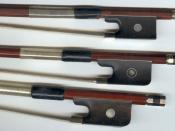Playing the viola allows my emotions to weave their way into my music. Shaping a discordant sound into expressive music has been a lengthy, laborious, but ultimately rewarding process.
I was switched from violin to viola by Melba Sandberg, a brusque, no-nonsense conductor at the New England Conservatory. During my violin seating audition, in what I thought was polite conversation, she remarked that my hands were large enough to play viola; had I ever thought of doing so? I replied that I hadn't, smiled, and played my piece. The following Saturday, nervous but excited, I brought my violin to the first rehearsal. When I walked in the door, Mrs. Sandberg accosted me and demanded, "Where's your viola?"
Under her pressure I switched, but the challenges of reading a new clef and adjusting my fingers were frustrating. It had taken me six years playing the violin to get into this orchestra.
Now I was expected to play a new instrument at high performance standards. This created enormous tension at home over the next few months. I would avoid practicing and complain about my "insensitive conductor" all week. This displeasure reached its climax every Saturday morning as my mother drove me into Boston for rehearsal.
During the ride home, however, a marked change was often evident. After playing the viola for three hours in the company of other musicians and discovering how wonderfully the viola combined with the entire spectrum of orchestral sound, I would soften. I wouldn't admit it, but I was beginning to like the viola.
The next spring I auditioned for and won a seat in the NEC Youth Symphony. Comfortable with my instrument and my place in the orchestra, I started to play with confidence. I also discovered the advantages of the viola. The viola doesn't need...


